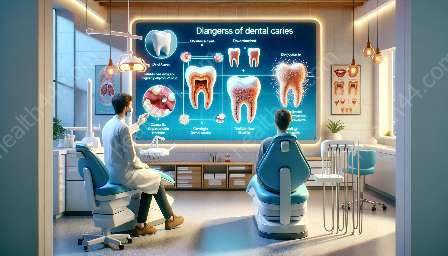When it comes to dental caries and poor oral health, understanding the environmental factors that contribute to their prevalence is crucial. In this comprehensive guide, we'll delve into the various environmental influences that can lead to dental caries and examine the effects of poor oral health on overall well-being.
What Are Dental Caries?
Dental caries, commonly known as tooth decay or cavities, is a multifactorial disease influenced by various environmental, behavioral, and biological factors. The prevalence of dental caries can be impacted by a wide range of environmental elements, including lifestyle, diet, socioeconomic status, and access to oral health care services.
Environmental Factors Contributing to Dental Caries Prevalence
1. Diet and Nutrition
One of the primary environmental factors contributing to dental caries is diet and nutrition. The consumption of sugary and acidic foods and beverages can create an environment conducive to the growth of cariogenic bacteria, leading to the demineralization of tooth enamel and the formation of cavities.
2. Socioeconomic Status
Socioeconomic status plays a significant role in dental caries prevalence. Individuals from lower socioeconomic backgrounds may face challenges accessing preventive dental care, including regular check-ups, fluoride treatments, and dental sealants, thereby increasing their susceptibility to dental caries.
3. Access to Oral Health Care Services
Access to oral health care services, including dental insurance coverage, availability of dental professionals, and proximity to dental facilities, directly influences the prevalence of dental caries. Limited access to quality oral health care services can lead to untreated caries and exacerbate oral health disparities.
4. Water Fluoridation
Community water fluoridation is a significant environmental factor in preventing dental caries. Fluoride, when present in optimal levels in drinking water, can help strengthen tooth enamel and reduce the risk of cavities, particularly in communities where access to professional dental care may be limited.
5. Oral Hygiene Practices
Environmental influences on oral hygiene practices, such as access to fluoride toothpaste, dental floss, and mouthwash, can impact the prevalence of dental caries. Inadequate oral hygiene behaviors may contribute to the accumulation of plaque and the development of caries.
The Effects of Poor Oral Health
Understanding the environmental factors that contribute to dental caries prevalence sheds light on the far-reaching effects of poor oral health. Individuals with untreated dental caries and inadequate oral hygiene may experience a range of adverse consequences, impacting their overall well-being and quality of life.
1. Pain and Discomfort
Untreated dental caries can lead to toothache, discomfort, and pain, affecting an individual's ability to eat, speak, and carry out daily activities. Persistent oral pain can significantly diminish an individual's quality of life and overall health.
2. Impact on Nutrition
Poor oral health, including dental caries, can hinder proper nutrition intake. Difficulties in chewing and discomfort while eating may lead to dietary restrictions and nutritional deficiencies, potentially impacting overall health and well-being.
3. Psychological and Social Impact
The effects of poor oral health extend beyond physical discomfort, influencing an individual's psychological well-being and social interactions. Dental caries and related oral health issues can lead to embarrassment, self-consciousness, and social isolation, affecting mental health and self-esteem.
4. Systemic Health Implications
Emerging research has highlighted potential links between poor oral health and systemic health conditions, such as cardiovascular disease, diabetes, and adverse pregnancy outcomes. Poor oral health may contribute to systemic inflammation and exacerbate existing health issues.
Conclusion
Environmental factors play a critical role in shaping the prevalence of dental caries and overall oral health outcomes. By acknowledging the impact of diet, socioeconomic status, access to oral health care, water fluoridation, and oral hygiene practices, we can work towards addressing the environmental determinants of poor oral health. Furthermore, understanding the effects of poor oral health on individuals' well-being underscores the importance of comprehensive oral health promotion and access to quality dental care services for all. By addressing the environmental influences on dental caries prevalence, we can strive to improve oral health outcomes and enhance overall health and quality of life.



